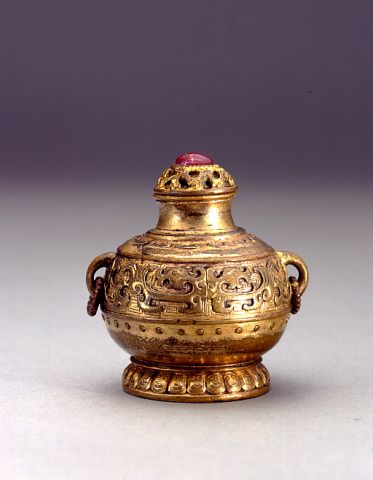
Bottle ID: 641
BRONZE WITH GOLD HU
Date: 1720-1770
Height: 38 mm
Bronze with gilding, cast as a miniature hu, the slightly compressed spherical body with a waisted neck with everted mouth, and circular splayed footrim, with two loop handles and loose rope-twist rings beneath the shoulders; the upper body with a band of two pairs of kui dragons between the handles, set on a leiwen (‘thunder pattern’) ground between raised beads, the shoulders with a band of inward facing ‘C’ scrolls with a further beaded border separating the shoulders and the neck, the mouth with an incised line defining the lip, the lower body with a band of raised bosses beneath the lower beaded border, the foot with a band of formalized, pendant lotus petals separated from the body by a raised, sharp-edged band.
Imperial, attributed to the Palace Workshops, Beijing.
Similar Examples:
Crane Collection no. 406.
Moss, Hugh, Victor Graham and Ka Bo Tsang. A Treasury of Chinese Snuff Bottles - The Mary and George Bloch Collection, 1995, Vol. 1, pp. 256-257, no. 105
Moss, Hugh, Victor Graham and Ka Bo Tsang. A Treasury of Chinese Snuff Bottles - The Mary and George Bloch Collection, 1998, Vol. 6, Part 3, pp. 811-812, no. 1380.
Provenance:
Hugh Moss (HK) Ltd.
Robert Kleiner, June 2006
John Ault
At first glance, (and without the stopper, which is not the original despite matching it impeccably), this might be taken for a miniature vase of the type made in the Palace workshops which were put in treasure boxes with other miniature works of art. Many of these treasure boxes with their contents remain in the Imperial Collection and are full of such trinkets made at the Palace workshops, while others contain older pieces, collected by the Qing emperors. Although the workmanship, archaistic style and material are all typical of the eighteenth century Palace workshops, other pieces from the treasure boxes would function as miniature vases for flowers, small water-vessels, brush-rests and so forth, whereas this example is too small to be anything else. That it was used as a snuff bottle is suggested by the very extensive wear both externally and internally. A miniature for a treasure box would have been made, put in the box, and largely forgotten, being rarely handled again, unless the box was taken on one of the Emperor’s seasonal tours. Additionally the flat lip suggests that it was a snuff bottle, rather than a small vase. A miniature hu without a stopper would have had a rounded lip, whereas this has a typical, flat, snuff-bottle lip to connect with the flat underside of the stopper. Internally, it can be seen that the walls are extensively scratched precisely where a spoon would touch the inside during the removal of snuff. Sloping inner necks are unusual for snuff bottles, but certainly not unknown, appearing on other Palace workshops bottles in hardstones, and on nineteenth century blue and white porcelain snuff bottles. It is the only known example of a Palace gilt-bronze bottle of this group of wares, which were standard fare in the Qianlong period, but also produced earlier, since archaism was beloved of both the Kangxi and Yongzheng Emperors.
< Back to full list
 English
English 中文
中文